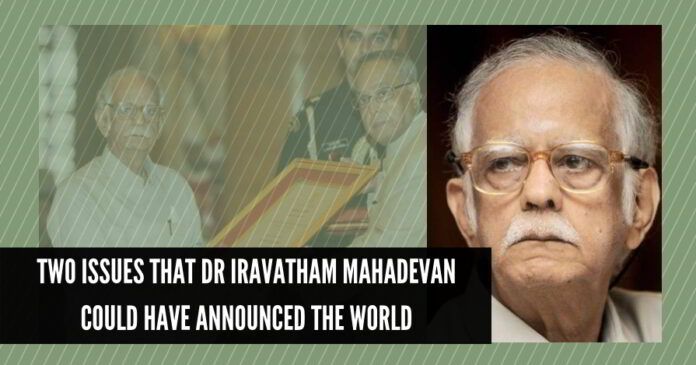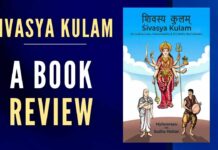
As one who has read most of his papers for a research work, the only thought lingering on this writer’s mind is that Mahadevan was truly humble and open for change.
With numerous tributes flowing around us on Iravatham Mahadevan at this moment of his departure, just one thought crosses this writer’s mind – that he was humble to the core. In spite of a long innings in epigraphy, he was very humble and honest to correct his views when faced with a convincing proof. He did make a correction as recently as in 2015 to one of the major assumptions on the Dravidian presence in the Indus upon which he built up his entire work of linguistic decipherment of the Indus Script. This makes us wonder whether he would have done the same to the other assumption on Aryan migration had he lived for some more time, for, there is a glaring absurdity in his original assumption of a small group of Aryans entering the country and the entire country getting linguistically fused with Aryan language though he proposed that the Aryans borrowed the culture of the Dravidian Indus!
He embraced the view of his predecessors that Dravidians were present in North West India (Indus Valley) when the Aryans came and Brahui is the proof of their presence.
Two issues are taken up as foregone conclusions.
The Aryan vs Dravidian debate on the Indus civilization was at the threshold of ‘Mature Phase’ when Mahadevan entered the fray in 1968. Only a couple decades prior to that, Wheeler presented his theory that Rig-Veda could be read as a historical document and wrote in his report on 1946 excavations of Harappa that ‘Indra stands accused’– by proposing a conflict between “the newly arrived Aryan warriors and the indigenous Indus peoples” (Possehl 2002). This was followed by attempts to decipher the signs on the Indus seals. When Mahadevan, after completing his work on Tamil-Brāhmī scripts, turned his attention to the Indus script, two studies were already published. Both these studies claimed that Dravidian language formed the substratum of the Indus script. Impressed with their findings, Mahadevan began his decipherment of the Indus seals on the same lines. The Aryan Invasion Theory (AIT) and the Dravidian substratum of the Indus were embraced as foregone conclusions by Mahadevan and taken up as the basic assumptions upon which he weaved all his decipherments.
Change of stance on Brahui as evidence.
He embraced the view of his predecessors that Dravidians were present in North West India (Indus Valley) when the Aryans came and Brahui is the proof of their presence. Though he made a fleeting reference to it in his paper published in 1970, he made a decisive statement in 1972 in his paper, “Study of the Indus script through bi-lingual parallels” where he wrote,
“It is now well established that the Dravidians were present in North-west India when the Aryans entered the country, most probably sometime around the middle of the Second Millennium B.C. The survival of the Brahui, a Dravidian language, and the presence of words of Dravidian origin in the Rigveda, provide irrefutable evidence for this fact.”
He had the humility and honesty to revise his opinion and admit it in the open certainly puts him on a high pedestal.
He repeated this in later works too though he never came up with any words of Dravidian origin in the Rig Veda. For him, the other proof, namely the continuing presence of Brahui even today constituted the basis for the assumption that Dravidians were living in North West India at the time of Aryan Invasion.
This stance on Brahui which he held on for more than 30 years came for a change when he was found to make a significant departure from his view on Brahui in his Convocation Address to the Dravidian University at Kuppam in 2015.
“I had earlier considered Brahui, a Dravidian language still spoken in Baluchistan as evidence for the Dravidian character of the Indus civilisation. I have revised my opinion as experts in Dravidian linguistics now hold that Brahui was originally a North-eastern Dravidian language with many shared features with Kurux and Malto and that it moved to its present location in later times.”
His academic sincerity in accepting facts notwithstanding, it is no exaggeration that this ‘revision’ of his view comes with a far-reaching implication on whether the Dravidian substratum can be taken for granted in Indus decipherment. This further raises questions like when did Brahui come to North West India and whether its arrival pre-dated Aryan arrival. Without finding answers for these, Mahadevan could have found himself forced to do a re-think on the assumption of Dravidian substratum given the fact that no convincing decipherment of the Indus script had come up till date. That he had the humility and honesty to revise his opinion and admit it in the open certainly puts him on a high pedestal.
Aryan as language and not race.
His adherence to Aryan Invasion Theory as a foregone conclusion was reflected in his 1972 paper as the only possible answer to the question of what happened to the Harappans. He wrote,
“Ethnic continuity overlaid by a linguistic change wrought by the incoming Aryans seems to be the only possible answer to the question, ‘What happened to the Harappans?’ ”
The newer revelations and discoveries coming on the Indus sites in his later years could have caused a change of mind on his Aryan assumption too.
With many researches having come with indisputable evidence on climatic causes for the demise of the Harappan / Indus civilization, the relevance of Aryan entry as a cause for the death of Indus civilization stands very much diluted and even non-existent. It is perplexing that Mahadevan did not ‘revise’ his view on Aryan invasion in the wake of new discoveries on the end of Indus civilisation.
A perception is gaining that Mahadevan treated Aryan and Dravidian as names of languages and not races. But the fact is that he did harp on these two as races and their merger as racial fusion in his early papers such as the one published in 1972.
His version was that a small group of Aryans entered the Indus and achieved dominance over the local population due to better mobility and advanced weaponry. By mentioning weaponry as a cause for domination he seemed to concur with the olden notion of invasion. Thus initially there were two races in his scheme which were fused in due course giving rise to two sets of language systems, Aryan and Dravidian.
According to him, the Dravidian language was present in the Indus. It was borrowed by Aryans from whom it travelled back to the Dravidian at a much later date. The later Dravidian was secondary Dravidian – the language that we have today. Using the Dravidian languages and the Aryan (Sanskrit) language, he attempted to decipher the Indus script (Primary Dravidian). In this methodology, there is absolutely no need to assume that Aryans came from outside and fused with the Indus people. In his scheme, there were pre-Aryan practices such as Soma cult that was borrowed by the Aryans! He even proposed pre-Aryan indigenous stock to which he attributed the Epics and Puranas of Hindus (1975 paper). All these do not require an outside stock (Aryans) to enter the Indus and re-create the same stuff. It is intriguing that he failed to think of an indigenously evolving ‘Aryan’ stock. This was because he was more conditioned to think on the dominant narrative of his day.
The newer revelations and discoveries coming on the Indus sites in his later years could have caused a change of mind on his Aryan assumption too. He did change his view on Brahui and it was only a matter of time before he changed his view in Aryan Invasion too. His sincerity in his research could have led him to that view if death had not snatched him now. If only he had lived for a few more years and retained the vigour, he might have come up with a ‘revision’ on his view on Aryan entry too. As one who has read most of his papers for a research work, the only thought lingering on this writer’s mind is that Mahadevan was truly humble and open for change.
References:
- Possehl, Greory L (2002). The Indus Civilization: A Contemporary Perspective. Rowman Altamira. Maryland. pp 237-238
- Mahadevan, Iravatham** (1970). “Dravidian Parallels in Proto-Indian script”. Journal of Tamil studies. II(1). pp 1-120.
- Mahadevan, Iravatham (1972). “Study of the Indus script through bi-lingual parallels”. The Second All India Conference of Dravidian Linguists. Sri Venkateswara University, Tirupati.
- Mahadevan, Iravatham (2015). “Interpreting the Indus Script: The Dravidian Solution”, Convocation Address delivered at the Dravidian University, Kuppam, 26 February 2015.
- Was Taj Mahal a Hindu temple or a palace or part of a twin temple? - November 13, 2023
- Does Agnihotra Homa offer protection from Corona Virus? - March 21, 2020
- Kejriwal owes his victory to MK Formula – the Coronavirus of Democracy! - February 14, 2020











Tamil Nationalists Naam Tamilar Party, Dr Paari Saalan, tamil Chinthanaiyalar peravai youtube channel – all have proven Tamil is the oldest language and tamil Siddhas religion was that of Shiva(enoch) and Murugan(Marduk).
Please watch the research videos of that channel and know how Brahmins(Indian Jews as claimed in their videos) have altered the Tamil Siddha Tradition and stolen Hinduism from the Tamil Tradition.
All religions, languages originated from Tamil.
https://www.youtube.com/watch?v=myWd_muzTRQ&list=PLZsrZkjp4837YNj_iD8G3VcHJazF_W5Sp
OK. Prof Mahadevan had the liberal outlook to change his mind. That sentence could have been sufficient in place of the whole article which, instead of intending to be so, anti Hindu rubbish. Whoever believes in any version of the Aryan Invation Theory is no scholar whether he be the subject of this article or its author. By the middle of the XIXth Century historiography had developed sufficiently in Europe to undeniably date and prove that the Old Testemant was not earlier than 1500 BC. So the Proselytisation Section of the India Office had to prove that nothing in Hindu Sripture was earlier than 1500 BC so as to make their saving of Indian souls credible. A committee of Anglican and Anglican-Catholic priests, and ICS officers sat in a government office room and invented the Aryan Invation theory and along with it the ‘races’ called Aryans and Dravidians. The theory and the ‘races’ have been convincingly rubbished by many scholars like Talegeri and Elst. So anyone who writes on these subjects with AIT assumption in mind has first to decolonisehis mind.
Mr. Sikkandar, What is your qualification? An expert on anthropology? history?
1)David Reich’s “Who We Are and How We Got Here” page 152-153 The Collision That Formed India
Genetically the Brahmins share a common ancestry with Central Asian steppe. In general, the upper castes in India have more Central Asian DNA than the lower castes, and the Harijans have the least DNA connection with Centrl Asians
2)In 1922 the US Supreme Court declared that white persons eligible for American citizenship had to be of Caucasian race. Indians hoping to circumvent the ruling , made the case that high caste Hindu, of full Indian blood, were in fact Caucasian, In 1923, the US Supreme Court ruled in the United States vs Bhagath Singh case that inter marriages between Aryan invaders and “dark skinned” Dravidians over the centuries had destroyed the purity of Aryan blood in India. Hence, Indians could not be considered “free white persons” and given American citizenship. In 1926, the Indian Central legislature banned Indian citizenship to American citizens
3)Bala Gangathar Tilak, in his book THE ARCTIC HOME OF VEDAS , asserts that vedic Aryans originated in North Pole and gradually migrated south to Iran and India.
From all the above, it is obvious Brahmins were external to Indian subcontinent, but now are claiming to be natives of land. It is like now even the uppercastes want to be classified as Backward Class in order to obtain the economic benefits.
Mr Saranathan, a PhD in astrology does not make one an expert on race study or protohistory
Outdated and totally crappy inference that would fail even a school standard evaluation. Recent genetic studies put almost all Indians of having the same genetic makeup. Bal Gangadhar Tilaks fantasy book is fit for school drama as his claim is unscientific especially when one see the current evidence on the post glacial period that started around 12K YBP. The people who could have survived the Ice age during the glacial period would have been the Neanderthals and not the Homosapiens. It is already proven through DNA studies conducted by HuGO (Human Genome Organisation) in a leading study on SNP Genetic markers in 2009 that Homosapiens migrated out of East Africa along the coast into India some 100K YBP. The coastal migration was because of the northern areas being extremely cold and also possibly because of the threat from the bigger and stronger Neanderthals who occupied the Northern Hemisphere. These people formed the Dravidian race. It was further migration along the coast and into SE Asia and Australia before they migrated northwards into China only after the post Glacial period when the earth became warmer and then into Central Asia, by which time the Neanderthals went extinct simply because of this global warming and climatic changes. These people in Central Asia then migrated into Europe as sea levels rose due to the melting Ice. By this time the dravidian race had already become highly civilised and had been settling throughout the world including Indonesia, S.E.Asia. The Sumerians were indeed Tamils and spoke the same language as those in the Indus Valley. Reference to all this are available in multitude of studies that had been suppressed by the likes of Max Muller and other western archaeologist and western educated Indians who had to fit their Christian time frame and superiority to rule over a highly intelligent Indian ancient society that had been subject to divide and rule.